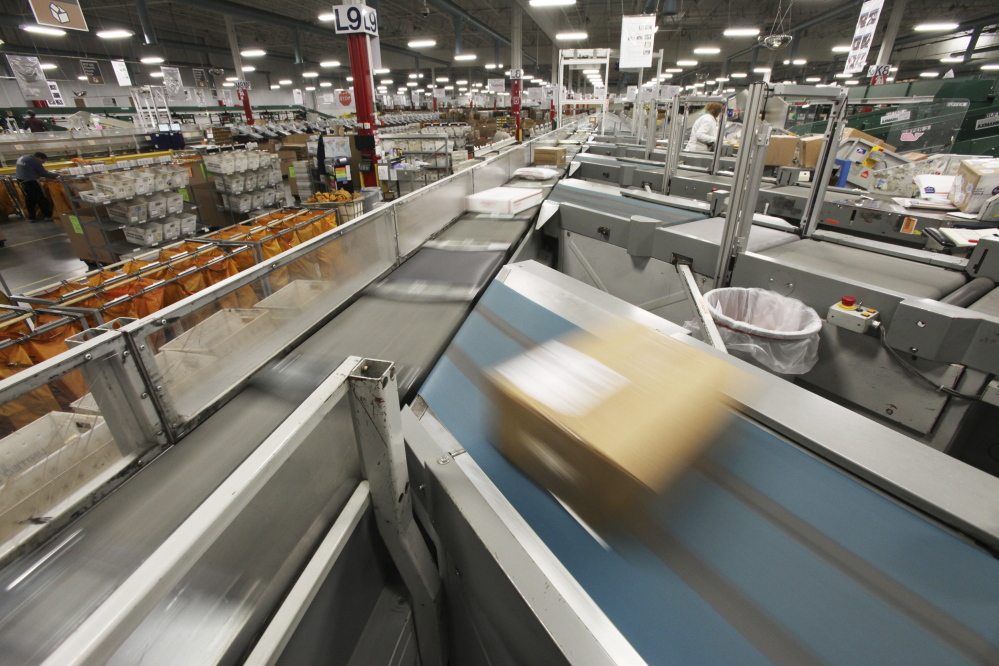Postal workers are sending a message – it’s taking longer for letters to be delivered.
Rallies to highlight the U.S. Postal Service’s lagging efficiency are scheduled for Thursday by workers who hope to raise public awareness of what they believe is a wrong-headed policy adopted by management – cutting back on regular mail service to save money.
“That’s our bread and butter,” said Tim Doughty, president of the American Postal Workers Union’s Portland local, which has about 500 members at the Scarborough mail distribution center, one of two sites in Maine where letters and packages are sorted for delivery. The union has another 170 to 200 members at the mail sorting center in Hampden, Doughty said.
USPS management wants to de-emphasize regular home and business mail delivery in favor of more package and shipping business, but Doughty said that course will “reduce the relevance of the Postal Service, leading to a downward spiral.”
The rallies – one from 5 to 6 p.m. Thursday on outer Congress Street, near the intersection with Interstate 295, and the other in Augusta from 8 a.m. to 5 p.m. at the post office on Western Avenue – come less than a week before the postal worker union’s contract expires. Doughty said the union isn’t focused so much on wage and benefit increases (wages range from $14 an hour to $33, depending on seniority), but rather on finding a way to slow the Postal Service’s strategy of closing distribution centers to save money, even as it leads to longer delivery times.
The USPS announced in January that it would no longer deliver local first-class mail the day after it’s posted. It said mail now takes an average of 2.1 days to be delivered, up from 1.8 days before the announcement. Average delivery times for individual states or regions aren’t available, said Maureen Marion, manager of corporate communications for the USPS in the Northeast.
The Postal Service is in the second round of distribution center closures. It closed 150 in the first round – the Hampden center was targeted but escaped – and saved $865 million, and plans to shut another 82 this year, saving $750 million more.
Even with those massive savings, the Postal Service hasn’t been able to avoid huge losses: $1.5 billion in the fiscal quarter ending in March, although that was $400 million less than it lost in the same period last year. Operating revenue was up $233 million because of growth in its shipping and package volume.
Marion said those numbers suggest the USPS is on the right track.
She said fewer people rely on the post office for daily communications – the volume of individual pieces of stamped mail is down 50 percent since 2006. It’s not just the increased reliance on email – consumers also do their banking and pay bills online, send electronic birthday cards and file their taxes online, she said, all contributing to the dramatic drop in volume.
But increased online shopping has made shipping packages a growth business, she said, and the post office has contracts to deliver the packages of big retailers, including Amazon.
Marion said that, in response to changing customer habits, the Postal Service cut hours at small post offices and has begun selling more stamps through grocery and drug stores – that’s where 40 percent of stamp sales now take place. The USPS is encouraging customers to print postage for packages at home, and people can schedule a pickup online, all reflecting changing preferences, she said.
“We really had to look hard at a big change, and it’s a hard change to do,” she said. “But the financials are better and they’re improving.”
However, Sen. Susan Collins, R-Maine, said those improved financial results are coming at a big cost.
“Late delivery of mail has been a real difficult problem,” Collins said. She said constituents have contacted her office to complain about the longer delivery times, a problem she said is acute in rural areas where there is a greater reliance on the Postal Service.
Collins echoed Doughty’s comments, saying the Postal Service could enter “a death spiral” as longer delivery times drive customers to cut back even more on using the mail.
“I believe the Postal Service actions are self-defeating,” said Collins, who met last week with Postmaster General Megan J. Brennan.
Collins said her biggest fear is that the Hampden processing center will be closed, and mail that is collected in northern Maine will be trucked to Scarborough for sorting and then back to northern Maine for delivery, causing delivery times to climb.
She recalled meeting with Brennan’s predecessor a few years ago, when the Hampden sorting center showed up on a closing list. She said she unfolded a map to try “to get him to understand the geography of the state” and recognize the impact that closing the center would have on mail delivery. Hampden was ultimately taken off the list.
Collins said there are ways for the Postal Service to turn things around, including increasing revenue. She told Brennan that the USPS should consider renting out unused space in distribution centers and selling ads on the sides of its trucks. It also should consider more “co-locating” plans, similar to the current arrangement of putting passport offices in post offices, she said.
Collins said she also told Brennan that the service has too many managers and needs to reform its workers’ compensation system, which costs $1 billion a year.
Adding revenue is better in the long run than cost-cutting that hurts the Postal Service’s performance, Collins said.
“The worst thing they could do is keep lowering their standards,” she said.
Send questions/comments to the editors.




Comments are no longer available on this story